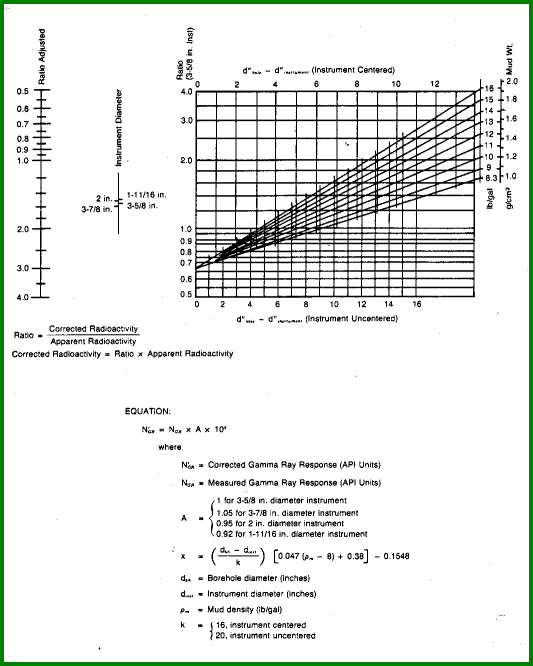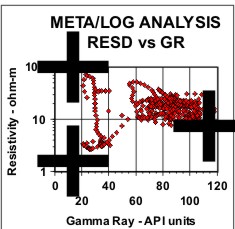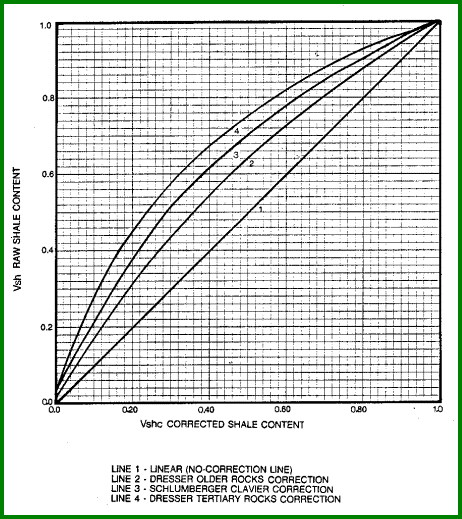|
 SHALE Volume FROM Gamma Ray LOGS
SHALE Volume FROM Gamma Ray LOGS
The
two most common shale indicating logs are the gamma ray
(GR) and spontaneous potential (SP) logs. The units of measurement
for GR are API units or counts per second, and for SP are
millivolts.
The
resistivity, neutron, and sonic are sometimes used individually,
and the separation between density porosity and neutron
porosity is also widely used. More rarely, the electromagnetic
propagation attenuation curve is available and is an excellent
shale indicator, especially in thin bedded (laminated) sand-shale
sequences.
There
are several flavours of gamma ray logs. The conventional
natural gamma ray log is usually abbreviated GR or SGR and
is the curve most commonly available. The natural gamma
ray spectral log produces the same total gamma ray curve,
usually abbreviated SGR. A second gamma ray curve, called
CGR, has the gamma rays from uranium filtered off. Thus CGR is always less than or
equal to SGR. If a CGR is available, it should be used in
preference to the SGR or GR logs.
 Gamma Ray Corrected for Borehole Effect
Gamma Ray Corrected for Borehole Effect
Borehole size,
mud weight, tool type, and poor calibration affect the gamma ray
response to the rocks. There are two ways to compensate for this.
One is to apply explicit borehole corrections to the log curve data,
as shown in this Section. Such explicit corrections cannot fix poor
calibration or logs in odd units (such as counts per second or
micrograms Radium equivalent per ton of rock. This is covered
in the next Section on this page which covers log normalization.
1:
IF DEPTHUNIT$ <> "METRIC"
2: THEN GRc = GR * (l + 0.04 * (MWT - 8.3)) * (1.0 + 0.06
* (CAL - 8))
3: IF DEPTHUNIT$ = "METRIC"
4: THEN GRc = GR * (1 + 0.000322 * (MWT - 1000)) * (1.0 +
0.0024 * (CAL - 203))
5: IF MWT = Null
6: OR IF BITZ = Null
7: OR IF CAL = Null
8: THEN GRc = GR
Where:
CAL = caliper log reading (hole size) (in or mm)
GR = gamma ray log reading (API units)
GRc = gamma ray log reading corrected for borehole size
and mud weight (API units)
MWT = mud weight (lb/US gal or kg/m3)
 COMMENTS:
COMMENTS:
The fixed constants in these formulae may need to be varied
for some logging tools. A chart indicating corrections for
more complex situations and the associated mathematical
formulae are shown below, courtesy of Dresser Atlas.
If mud properties are unknown, the usual solution is to
do nothing and use the GR value as is.
 RECOMMENDED
PARAMETERS:
RECOMMENDED
PARAMETERS:
None. Default value for MWT is usually 10 lb/USgal or 1250kg/m3

Borehole Corrections for Gamma Ray
 Gamma Ray LOG NORMALIZATION
Gamma Ray LOG NORMALIZATION
Gamma ray log normalization is based on the concept that all
clean sands in an area should have the same GR log reading,
and that all pure shales should have the same GR values. The
assumption includes the fact that there is a clean sand and
a pure shale in each well in the zone of interest (or at
least nearby) and that there are no major geological reasons
for the values to vary across space. Normalization also
helps reduce mud weight and hole size effects, but the
explicit corrections are probably best if done first, then
normalization applied afterward.
The equation is:
9: GRn = GRMIN + (GRMAX - GRMIN) * (GRcor - GRLOW)
/ (GRHIGH - GRLOW)
Where:
GRn = normalized gamma ray (API units)
GRcor = input gamma ray corrected for borehole and mud weight (any
units)
GRMIN = GR clean sand value to normalize to (API units)
GRMAX = GR shale value to normalize to (API units)
GRLOW = GR clean sand value in this well/zone (any units)
GRHIGH = GR shale value in this well/zone (any units)
CAUTION: Normalization can remove natural geological
variations that may have significance in understanding the
reservoir variations across space. For example, if calcite
cement varies from place to place, normalization will remove
porosity trends that vary with cementation. Similarly, on a
GR log if feldspar content or clay type varies, this
knowledge will be lost.
 COMMENTS
COMMENTS
This is the method most used for GR and SP curves but can be
used with care on any log curve.
 NUMERICAL
EXAMPLE
NUMERICAL
EXAMPLE
Assume you want to re-scale all GR logs so that all clean
lines are at 20 API units and all shale lines are at 120 API
units. That makes GRMIN = 20 API units, GRMAX = 120 API
units for all wells
Assume GRLOW = GR0 = 30 API units, GRHIGH = GR100 = 145 API
units in THIS zone in this well.
Assume actual GR at a depth level = 55 API units
1: GRn = 20 + (120 - 20) * (55 - 30)
/ (155 - 30) = 40 API units

Shale Volume from the Gamma Ray
The response equation for the gamma ray log follows the
classical form:
10:
GR = PHIe * Sxo * GRw (water term)
+ PHIe * (1 - Sxo) * GRh (hydrocarbon term)
+ Vsh * GRsh (shale term
+ (1 - Vsh - PHIe) * Sum (Vi * GRi) (matrix term)
Where:
GRh = log reading in 100% hydrocarbon
GRi = log reading in 100% of the ith component of matrix
rock
GR = log reading
GRsh = log reading in 100% shale
GRw = log reading in 100% water
PHIe = effective porosity (fractional)
Sxo = water saturation in invaded zone (fractional)
Vi = volume of ith component of matrix rock
Vsh = volume of shale (fractional)
Both
GRw and GRh are zero. GRi is equal to the background radiation
in non-shaly rock and is called GR0 in this book. GRsh is
the log reading in shale, called GR100 here. The effect
of porosity is very small, so that term also is assumed
to be zero. The response equation thus reduces to:
11:
GR = Vsh * GR100 + (1 - Vsh) * GR0
When
solved for Vsh, this equation becomes:
12:
VSHgr = (GR - GR0) / (GR100 - GR0)
13: VSHgr = Min(1, Max(0, VSHgr))
Where:
GR = gamma ray log reading in zone of interest corrected
for borehole size (API units)
GR0 = gamma ray log reading in l00% clean zone (API units)
GRl00 = gamma ray log reading in l00% shale (API units)
VSHgr = shale volume from gamma ray log (fractional)
  COMMENTS:
COMMENTS:
Apply borehole corrections and normalize logs if desired
before doing Vsh calculations.
Use CGR, if available, in preference to GR or SGR curves.
CGR has uranium effect removed.
Do not apply borehole corrections to ECGR - that step has
already been done at thhe lpgging unit. Read log heading
comments to see what was done at the wellsite.
The gamma ray method for shale volume is preferred in the
majority of cases. The exceptions are radioactive dolomites
and sandstones, and zones which contain feldspar or
uranium.
Use of the data from the
natural gamma ray spectral log helps to resolve these
cases. See following sections.
 References:
References:
1. Gamma Ray Well Logging,
L.G. Howell, A Forsch, Geophysics, 1939.
2. Gamma Ray Logging,
F.P. Kokesh, Oil and Gas Journal, 1951.
3. Shaly Sand Evaluation Using Gamma Ray Spectrometry,
G. Marett, P. Chevalier, P.Souhuite, J. Suau, SPWLA, 1976.
 RECOMMENDED
PARAMETERS:
RECOMMENDED
PARAMETERS:
Range Default
GR0 5 to 50 15 API units
GR100 80 to 150 115 API units
Choose from crossplot or from depth plot.
 NON-LINEAR ADJUSTMENT TO CALCULATED SHALE VOLUME
NON-LINEAR ADJUSTMENT TO CALCULATED SHALE VOLUME
Various studies have shown that the GR, and in some cases
the SP, is not a linear prediction of shale volume. Various
formulae are used to modify the linearly derived shale volume
to obtain a more satisfying answer.
Schlumberger
Clavier equation.
14: IF NONLINSWITCH$ = "CLAVIER"
15: THEN VSHc = 1.7 - (3.38 - (VSHgr + 0.7) ^ 2) ^ 0.5
Dresser
tertiary equation.
16: IF NONLINSWITCH$ = "TERTIARY"
17: THEN VSHc = 0.083 * (2 ^ (3.7 * VSHgr) - 1)
Dresser
older rock equation.
18: IF NONLINSWITCH$ = "OLDERROCKS"
19: THEN VSHc = 0.33 * (2 ^ (2 * VSHgr) - 1)
19: OTHERWISE Vshc = Vsh
Where:
VSHgr = shale content from GR or SP (fractional)
VSHc = shale content corrected for non-linear effects (fractional)
 COMMENTS:
COMMENTS:
Vsh must be within the range of 0.0 to 1.0 before applying
these formulae. The Clavier equation is a good compromise
between the tertiary and older rock equations. The graph
below
illustrates these curves.

Non-Linear Adjustments to Shale Volume
 RECOMMENDED
PARAMETERS:
RECOMMENDED
PARAMETERS:
None.
 Shale Volume From Spectral Gamma Ray Log
- THORIUM Shale Volume From Spectral Gamma Ray Log
- THORIUM
The algebraic formula to solve for shale volume from the
gamma ray spectrolog is in the same form as the normal gamma
ray.
20:
VSHth = (TH - TH0) / (TH100 - TH0)
21: VSHth = Min(1, Max(0, VSHth))
Where:
TH = gamma ray spectrolog reading in zone of interest, thorium
only (ppm)
TH0 = gamma ray thorium reading in 100% clean zone (ppm)
TH100 = gamma ray thorium reading in 100% shale (ppm)
VSHth = shale volume from thorium curve of gamma ray spectrolog
(fractional)
 COMMENTS:
COMMENTS:
The gamma ray spectral
log thorium curve for shale volume is preferred in dolomites
and sandstones which are radioactive due to uranium content,
and zones which contain feldspar.
 Shale Volume from Gamma Ray Spectrolog
- Potassium Shale Volume from Gamma Ray Spectrolog
- Potassium
22: VSHk = (K - K0) / (K100 - K0)
23: VSHk = Min(1, Max(0, VSHk))
Where:
K = gamma ray spectrolog reading in zone of interest, potassium
only (percent)
K0 = gamma ray potassium reading in 100% clean zone (percent)
K100 = gamma ray potassium reading in 100% shale (percent)
VSHk = shale volume from potassium curve of gamma ray spectrolog
(fractional)
 COMMENTS:
COMMENTS:
The gamma ray spectrolog potassium curve for shale volume
is an alternative method in dolomites and sandstones, which
are radioactive due to uranium content. It cannot be used
in zones which contain feldspar and its derivatives, such
as kaolinite.
Two formulae commonly seen are:
 Shale Weight from the Gamma Ray Spectrolog
Shale Weight from the Gamma Ray Spectrolog
24. Wfel = (TH / THCL - K / KCL) / (THFEL / THCL - KFEL / KCL)
25. Wcl = (TH / THFEL - K / KFEL) / (THCL / THFEL - KCL /
KFEL)
Where:
K = potassium log reading (percent)
KCL = potassium log reading in 100 % clay (percent)
KFEL = potassium log reading in 100 % feldspar (percent)
TH = thorium log reading (ppm)
THCL = thorium log reading in 100 % clay (ppm)
THFEL = thorium log reading in 100 % feldspar (ppm)
Wcl = weight of clay (fractional)
Wfel = weight of feldspar (fractional)
Volumetric
fractions of clay and feldspar can be obtained from the
density of each constituent. The method is only practical
if the potassium and thorium clay values are represented
effectively by the log readings in shale. I have no experience
with this method, so I cannot recommend it with confidence,
 RECOMMENDED
PARAMETERS:
RECOMMENDED
PARAMETERS:
Range Default
TH0 0 to 5 0 ppm
TH100 10 to 15 10 ppm
FEL0 0 to 0.5 0 percent
FEL100 2.0 to 25 2 percent
 NUMERICAL EXAMPLE
NUMERICAL EXAMPLE
|
GR
= 75 API units |
TH
= 5 ppm |
|
GR0
= 45 API units |
TH0
= 0 ppm |
|
GR100
= 135 API units |
TH100
= 10 ppm |
|
SP
= -50 mv |
K
= 1.5 % |
|
SP0
= -90 mv |
K0
= 0 % |
|
SP100
= 0 mv |
K100
= 3.0 % |
|
PHIN
= 0.28 |
|
|
PHINSH
= 0.30 |
|
|
PHID
= 0.12 |
|
|
PHIDSH
= 0.03 |
|
|
1.
Vsh from gamma ray log:
VSHgr = (75 - 45) / (135 - 45) = 0.33
2. Vsh from gamma ray spectrolog thorium curve:
VSHth = (5 - 0) / (10 - 0) = 0.50
3. Vsh from gamma ray spectrolog potassium curve:
VSHk = (1.5 - 0) / (3 - 0) = 0.44
4. If hole size was 400 mm at the shale point, and mud weight
was 1250 kg/m3, the GR log would read low and a correction
would be needed:
GR100 = 135 * (1 + 0.000322 * (1250 - 1000))*(1 + 0.0024*(400
- 203)) = 217 API units
VSHgr = (75 - 45) / (217 - 45) = 0.18
This
is approximately one half the value without the hole correction
applied.
Assume Vsh = 0.50 (50%)
, apply non-linear corrections.
5.
Clavier equation:
VSHc = (1.7 - (3.38 - (0.50 + 0.7) ^ 2) ^ 0.5 = 0.30
6.
Tertiary equation:
VSHc = 0.083 * (2 ^ (3.7 * 0.50) - 1) = 0.15
7.
Older rocks equation:
VSHc = 0.33 * (2 ^ (2 * 0.50) - 1) = 0.33
|

